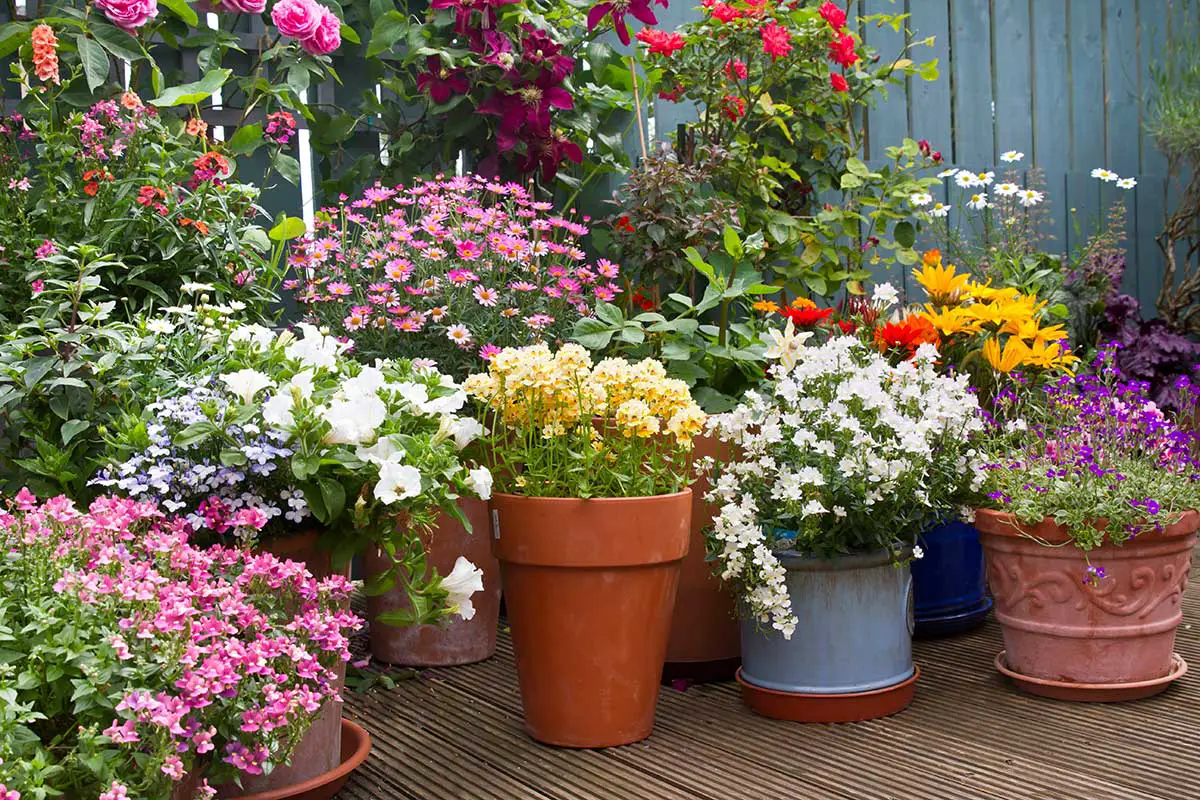Container gardening opens a world of botanical possibilities to those that don’t have the space or time to plant a traditional garden. Whether you’re limited to a walkway, a small deck or balcony, a small patch of sunshine in your driveway, or want to add versatility to your backyard, container gardening could be the best option for creating the space you desire.
Choosing and combining the best plants to fill your containers can seem intimidating. There are no “rules” aside from giving the plants what they need to thrive. Be imaginative, experiment, and have fun—mix perennials, annuals, vegetables, herbs, ornamental trees, and shrubs. If you don’t like what you’ve created, start again.
Balance and Contrast Is Key
Containers should be sized to your space, and plants should be sized to your container. Small containers will be lost in an ample space, just as small plants will be lost in a large container. When choosing the correct size of a container, keep in mind that a plant shouldn’t be more than 1 ½ times as wide or twice the height of the container.
If you have a flamboyant and vibrant plant, stick it in a simple container. Additionally, ornate containers are better showcased when paired with a simple plant. Color plays an intricate role in designing your container garden.
Color Is Important
If you’re looking for a dramatic effect and adding contrast, choose colors opposite each other on the color wheel (yellows with purples, reds with greens, blues with oranges). To be more harmonious, stay with different shades of the same color (lavender, lilac, purple).
Containers can add color to a space. Make sure not to camouflage colorful containers with “spiller” plants (trailing plants that go down the side of a container). And don’t be overwhelmed trying to plant several variations in one container. Bold plants can shine in a container alone; then, you can group single containers.
Thrillers, Spillers, and Fillers
An easy guideline to follow when choosing the best plants to combine in a container is having a “thriller, spiller, and a filler.” Start with having at least one focal-point plant (thriller), combine with plants that spill over the edge (spillers), and finish with plants with smaller leaves and flowers to add fill and color all season long (fillers).
Thrillers
A focal point can be created in a container of mixed plants through bold leaves, striking color, or height. Avoid falling into your container looking one-dimensional, and remember to create different levels. Here’s a list of examples to add bold leaves, striking colors, or height:
- Agave
- Cannas
- Common boxwood (Buxus sepervirens)
- Datura (Datura stramonium)
- Elephant ear (Alocasia esculenta)
- Hibiscus
- Phormium
- Purple Fountain Grass (Pennisetum setaceum ‘Rubrum’)
- Spilled Wine Weigela (Weigela florida ‘Bokraspiwi’)
Spillers
The best spiller plant is one with a long blooming season that doesn’t need immediate deadheading. Plant breeders continue to develop better choices of these types of plants. Annuals do best in either cool or warm weather and can be swapped out when the weather changes. Here’s a list of spiller plants you can consider:
- Alyssum
- Asarina (Chickabiddy)
- Bidens
- Calibrachoa (Million Bells)
- Creeping Zinnia (Sanvitalia)
- Ivy geranium (Perlargonium peltatum)
- Lotus berthelotii (Parrot’s beak)
- Scaevola (Fan Flower)
- Verbena
Fillers
Designing your container garden relies heavily on the plants you choose to fill your empty spaces. These are the plants that can make or break your space. They must be complementary, highlight the focal points, and perform well over a long period. Foliage is a great way to add color while creating the bones of your garden. Here’s a list of some to consider:
- Agastache foeniculum (Anise Hyssop)
- Basil
- Celosia (plume flower)
- Coleus (Solenostemon scutellarioides)
- Diamond Frost Euphorbia (Euphorbia ‘Inneuphdia’)
- Fuchsia
- Lantana (Lantana camara)
- Ornamental Cabbage and Kale
- Ornamental Pepper (Capsicum annuum)
- Parsley
- Sundaze Blaze (Bracteantha (Xerochrysum) ‘Flobrabla’)
- Swiss Chard
- Twisted Dart Juncus (Juncus tenuis)
Final Thoughts on Container Gardening
You can find many more ideas in seed catalogs and your local garden centers for choosing the best plants for your container garden. Visiting your local garden centers can also help you determine which plants will best fit your planting zone. Some zones require hardier plants due to drastic weather changes.
Almost any shrub, small tree, vegetable, herb, or flower can successfully grow in a container. If you try a plant and it doesn’t work out, cut it down and try something else. Just remember there are no rules for container gardens except to give the plants the best environment to thrive. Be imaginative. Experiment. And most importantly, have fun.
Watch this informative video to learn how you can surround yourself with beautiful flowers or grow your own culinary herbs and vegetables by using a variety of containers.
Happy gardening!




